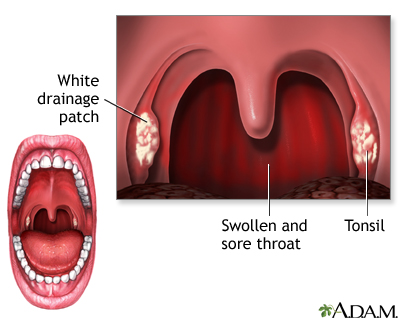Strep throat
Pharyngitis - streptococcal; Streptococcal pharyngitis; Tonsillitis - strep; Sore throat strep
Strep throat is a disease that causes a sore throat (pharyngitis). It is an infection with a bacteria called group A streptococcus.

Sometimes when you have a sore throat, it's more than just a normal cold, especially if your throat feels raw or like it's on fire. Most people get sore throats from a viral infection, in other words, the common cold. But, occasionally, you might come down with strep throat, which is caused by a type of bacteria called Streptococcus pyogenes. These bacteria are contagious. Like with germs that cause a cold, you can also get strep throat from handling a doorknob or other surface, then touching your nose or mouth. How do you know for sure that you have strep throat? You may start to feel sick a few days after you come into contact with the bacteria that causes strep throat, but usually people will start feeling sick suddenly. You will probably have a fever very quickly, and your throat will be very sore. If you look in a mirror, the back of your throat may be very red, and you might see white patches on your tonsils. You may also have a headache, be sick to your stomach, and feel chills. Your doctor will check your throat for redness, swelling, and white patches, then rub a sterile swab over your tonsils, taking a sample of mucous. A rapid antigen test done at your doctor's office can find bacteria from the swab in minutes, so you can find out if strep throat is causing your symptoms. Your doctor will probably send the swab to a laboratory to double check your diagnosis, but this test may take a day or two. There's another common type of bacteria that can cause throat infections, especially in young adults; The bacteria's name is Fusobacterium necrophorum. I call it F-throat. Antibiotics are important for F-throat. It doesn't show up on strep tests, so it's important to keep in mind with severe sore throats or sore throats that aren't getting better as expected. Since strep does NOT cause most sore throats, your doctor will make sure you have it before treating you for it. If you do, your doctor will most likely ask you to take penicillin or amoxicillin for 10 days, even though you might feel much better after a few days. The reason is because strep throat can sometimes lead to more serious health problems, such as rheumatic fever. Be sure to tell your doctor if you're allergic to some antibiotics, so you can receive a different medication. While you wait for the antibiotics to start fighting the infection, you can follow these tips to help your throat feel better; Drink warm liquids like tea with honey; Gargle several times a day with a teaspoon of salt in a cup of warm water; Drink cold liquids, or suck on popsicles, hard candies, or throat lozenges; Keep a vaporizer or humidifier running in your room to soothe the dryness in your throat AND Take over-the-counter pain medicines. It's important to see your doctor if you think you have strep throat, because, untreated, it can lead to very serious health problems. Once you start treatment, your symptoms will probably be gone in about a week. But if you don't start feeling in a day or two, make sure you call your doctor.

Structures of the throat include the esophagus, trachea, epiglottis and tonsils.

Strep throat is the most common bacterial cause of sore throat. Because strep throat can occasionally lead to rheumatic fever, antibiotics are given. Strep throat often includes a fever (greater than 101 degrees Fahrenheit or 38.3 degrees Centigrade), white draining patches on the throat, and swollen or tender lymph glands in the neck. Children may have headache and stomach pain.

A throat swab can be used to determine if Group A Streptococcus bacteria is the cause of pharyngitis in a patient.
Causes
Strep throat is most common in children from ages 5 and 15, although anyone can get it.
Strep throat is spread by person-to-person contact with fluids from the nose or saliva. It commonly spreads among family or household members.
Symptoms
Symptoms appear about 2 to 5 days after coming in contact with the strep germ. They may be mild or severe.
Common symptoms include:
- Fever that may begin suddenly and is often the highest on the second day
- Chills
- Red, sore throat that may have white patches
- Pain when swallowing
- Swollen, tender neck glands
Other symptoms may include:
- General ill feeling
- A loss of appetite and abnormal sense of taste
- Headache
- Nausea
Some strains of strep throat can lead to a scarlet fever-like rash. The rash first appears on the neck and chest. It may then spread over the body. The rash may feel rough like sandpaper.
The same germ that causes strep throat may also cause symptoms of a sinus infection or an ear infection.
Exams and Tests
Many other causes of sore throat may have the same symptoms. Your health care provider must do a test to diagnose strep throat and decide whether to prescribe antibiotics.
A rapid strep test can be done in most provider offices. However, the test may be negative, even if strep is present.
If the rapid strep test is negative and your provider still suspects that the strep bacteria is causing the sore throat, a throat swab can be tested (cultured) to see if strep grows from it. Results will take 1 to 2 days.
Treatment
Most sore throats are caused by viruses, not bacteria.
A sore throat should be treated with antibiotics only if the strep test is positive. Antibiotics are taken to speed up your recovery and to prevent rare but more serious health problems, such as rheumatic fever.
Penicillin or amoxicillin are most often the first drugs to be tried.
- Certain other antibiotics may also work against the strep bacteria.
- Antibiotics should be taken for 10 days, even though symptoms are often gone within a few days.
The following tips may help your sore throat feel better:
- Drink warm liquids, such as lemon tea or tea with honey.
- Gargle several times a day with warm salt water (1/2 tsp or 3 grams of salt in 1 cup or 240 milliliters water).
- Drink cold liquids or suck on fruit-flavored ice pops.
- Suck on hard candies or throat lozenges. Young children should not be given these products because they can choke on them.
- A cool-mist vaporizer or humidifier can moisten and soothe a dry and painful throat.
- Try over-the-counter pain medicines, such as acetaminophen (Tylenol) or ibuprofen (Advil, Motrin).
Outlook (Prognosis)
Symptoms of strep throat most often get better in about 1 week. Untreated, strep can lead to serious complications.
Possible Complications
Complications may include:
- Kidney disease caused by strep
- A skin condition in which small, red, and scaly teardrop-shaped spots appear on the arms, legs, and middle of the body, called guttate psoriasis
- Abscess in the area around the tonsils
- Rheumatic fever
- Scarlet fever
When to Contact a Medical Professional
Contact your provider if you or your child develops the symptoms of strep throat. Also, contact your provider if symptoms do not get better within 24 to 48 hours of starting treatment.
Prevention
Most people with strep can spread the infection to others until they have been on antibiotics for 24 to 48 hours. They should stay home from school, daycare, or work until they have been on antibiotics for at least a day.
Get a new toothbrush after 2 or 3 days, but before finishing the antibiotics. Otherwise, the bacteria can live on the toothbrush and reinfect you when the antibiotics are done. Also, keep your family's toothbrushes and utensils separate, unless they have been washed.
If repeated cases of strep still occur in a family, check to see if someone is a strep carrier. Carriers have strep in their throats, but the bacteria do not make them sick. Sometimes, treating them can prevent others from getting strep throat.
References
Flores AR, Caserta MT. Pharyngitis. In: Bennett JE, Dolin R, Blaser MJ, eds. Mandell, Douglas, and Bennett's Principles and Practice of Infectious Diseases. 9th ed. Philadelphia, PA: Elsevier; 2020:chap 59.
Sur DK, Plesa ML. Antibiotic use in acute upper respiratory tract infections. Am Fam Physician. 2022;106(6):628-636. PMID: 36521460
Tanz RR. Acute pharyngitis. In: Kliegman RM, St. Geme JW, Blum NJ, Shah SS, Tasker RC, Wilson KM, eds. Nelson Textbook of Pediatrics. 21st ed. Philadelphia, PA: Elsevier; 2020:chap 409.
van Driel ML, De Sutter AI, Thorning S, Christiaens T. Different antibiotic treatments for group A streptococcal pharyngitis. Cochrane Database Syst Rev. 202116;3(3):CD004406. PMID: 33728634
Version Info
Last reviewed on: 7/8/2023
Reviewed by: Linda J. Vorvick, MD, Clinical Professor, Department of Family Medicine, UW Medicine, School of Medicine, University of Washington, Seattle, WA. Also reviewed by David C. Dugdale, MD, Medical Director, Brenda Conaway, Editorial Director, and the A.D.A.M. Editorial team.
